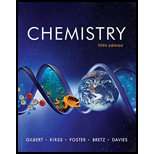
(a)
Interpretation: Two different images showing different arrangement of particles is given. The class of matter (an element, a compound, a homogenous mixture, or a heterogeneous mixture) and the physical state in the given images is to be stated.
Concept introduction: The space between the particles of solids is very less, so they just vibrate at their own place, while the specie between the particles of liquid is more as compared to solids. The space between particles of gas is very large so they can easily move and collide with each other and with the walls of the container.
When the atoms belonging to different elements are chemically combined in a fixed ratio then it leads to the formation of a compound while when the atoms of same type are combined together then it leads to the formation of an element.
The homogeneous mixture consists of same uniform composition and appearance throughout the mixture while the heterogeneous mixture has non-uniform composition throughout the mixture.
To determine: The class of matter (an element, a compound, a homogenous mixture, or a heterogeneous mixture) and the physical state in the given image.
(a)
Answer to Problem 1.1VP
Solution
The given image shows that the species present inside the box is a pure compound and is present in the gaseous state.
Explanation of Solution
Explanation
The given image shows that the species present inside the box is a pure compound because it consists of only red and blue balls that are combined together. It consists of only two types of elements that are joined together; therefore it is not a homogeneous mixture. As it is seen that the space between the compounds is very large and they are free to move in the entire space, it means it represent the gaseous state.
(b)
To determine: The class of matter (an element, a compound, a homogenous mixture, or a heterogeneous mixture) and the physical state in the given image.
(b)
Answer to Problem 1.1VP
Solution
The given image shows that the species present inside the box is a homogeneous mixture and is present in gaseous state.
Explanation of Solution
Explanation
The given image shows that the species present inside the box is a homogeneous mixture. It consists of two different balls that represent the elements. As two balls of a particular color are joined together, therefore, they form a molecule. As these two different molecules are uniformly distributed, therefore, the given mixture is homogeneous. As it is seen that there is a large space between the different molecules so that they are free to rotate. Therefore, the given molecules are in gaseous state.
Conclusion
The shape of matter depends on the arrangement of particles from which the matter is made up of that is whether it is solid, liquid or gas
Want to see more full solutions like this?
Chapter 1 Solutions
Chemistry: The Science in Context (Fifth Edition)
- At an electrified interface according to the Gouy-Chapman model, what types of interactions do NOT occur between the ions and the solvent according to this theory?arrow_forwardPlease predict the products for each of the following reactions. Clearly show the regiochemistry (Markovnikov vs anti-Markovnikov) and stereochemistry (syn- vs anti- or both). If a mixture of enantiomers is formed, please draw all the enantiomers. Hint: In this case you must choose the best answer to demonstrate the stereochemistry of H2 addition. 1.03 2. (CH3)2S BIZ CH₂OH 2. DMS KMnO4, NaOH ΖΗ Pd or Pt (catalyst) HBr 20 1 HBr ROOR (peroxide) HO H-SO HC 12 11 10 BH, THE 2. H2O2, NaOH Brz cold HI 19 18 17 16 MCPBA 15 14 13 A Br H₂O BH3⚫THF Brz EtOH Pd or Ni (catalyst) D₂ (deuterium) 1. Os04 2. H2O2 CH3CO3H (peroxyacid) 1. MCPBA 2. H₂O* H B + H H H "H C H H Darrow_forwardExplain how Beer’s Law can be used to determine the concentration in a selected food sample. Provide examples.arrow_forward
- Explain the importance of having a sampling plan with respect to food analysis. Explain the importance of having a sampling plan with respect to food analysis. Provide examples.arrow_forwardPlease predict the products for each of the following reactions. Clearly show the regiochemistry (Markovnikov vs anti-Markovnikov) and stereochemistry (syn- vs anti- or both). If a mixture of enantiomers is formed, please draw all the enantiomers. cold KMnO4, NaOH 2. DMS 1. 03 CH3OH Br2 1. 03 2. (CH3)2S H₂ Pd or Pt (catalyst) HBr 18 19 20 1 HBr ROOR (peroxide) H₂O H₂SO4 HCI HI 17 16 6 15 MCPBA 1. BH3 THF 2. H₂O2, NaOH 1. OsO4 2. H₂O₂ 110 CH3CO₂H (peroxyacid) 1. MCPBA 2. H₂O* Br2 H₂O BH3 THF B12 EtOH Pd or Ni (catalyst) D₂ (deuterium) Bra A B C D H OH H OH OH H OH α α α OH H OH OH фон d H "Harrow_forwardBriefly indicate the models that describe the structure of the interface: Helmholtz-Perrin, Gouy-Chapman, Stern and Grahame models.arrow_forward
 ChemistryChemistryISBN:9781305957404Author:Steven S. Zumdahl, Susan A. Zumdahl, Donald J. DeCostePublisher:Cengage Learning
ChemistryChemistryISBN:9781305957404Author:Steven S. Zumdahl, Susan A. Zumdahl, Donald J. DeCostePublisher:Cengage Learning ChemistryChemistryISBN:9781259911156Author:Raymond Chang Dr., Jason Overby ProfessorPublisher:McGraw-Hill Education
ChemistryChemistryISBN:9781259911156Author:Raymond Chang Dr., Jason Overby ProfessorPublisher:McGraw-Hill Education Principles of Instrumental AnalysisChemistryISBN:9781305577213Author:Douglas A. Skoog, F. James Holler, Stanley R. CrouchPublisher:Cengage Learning
Principles of Instrumental AnalysisChemistryISBN:9781305577213Author:Douglas A. Skoog, F. James Holler, Stanley R. CrouchPublisher:Cengage Learning Organic ChemistryChemistryISBN:9780078021558Author:Janice Gorzynski Smith Dr.Publisher:McGraw-Hill Education
Organic ChemistryChemistryISBN:9780078021558Author:Janice Gorzynski Smith Dr.Publisher:McGraw-Hill Education Chemistry: Principles and ReactionsChemistryISBN:9781305079373Author:William L. Masterton, Cecile N. HurleyPublisher:Cengage Learning
Chemistry: Principles and ReactionsChemistryISBN:9781305079373Author:William L. Masterton, Cecile N. HurleyPublisher:Cengage Learning Elementary Principles of Chemical Processes, Bind...ChemistryISBN:9781118431221Author:Richard M. Felder, Ronald W. Rousseau, Lisa G. BullardPublisher:WILEY
Elementary Principles of Chemical Processes, Bind...ChemistryISBN:9781118431221Author:Richard M. Felder, Ronald W. Rousseau, Lisa G. BullardPublisher:WILEY





